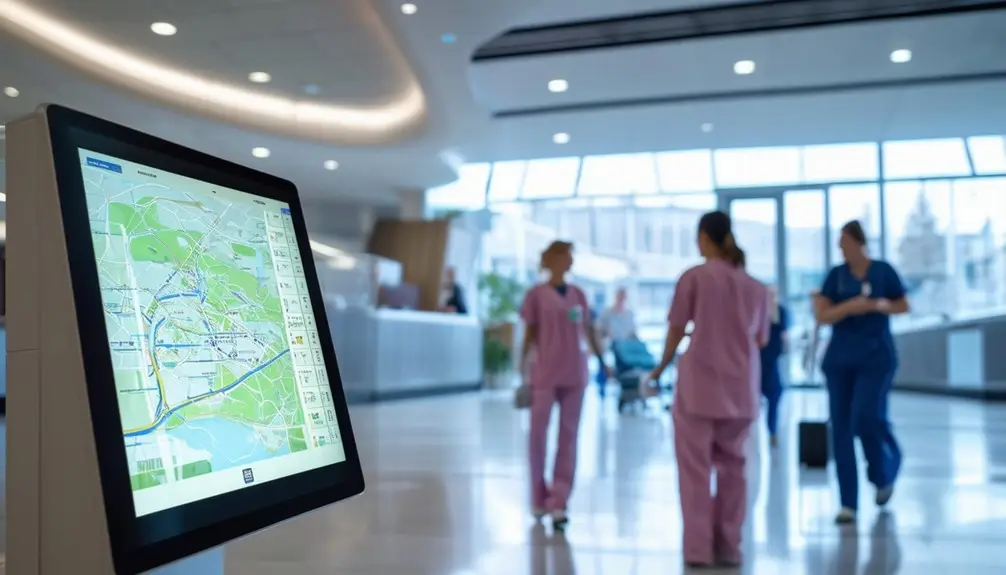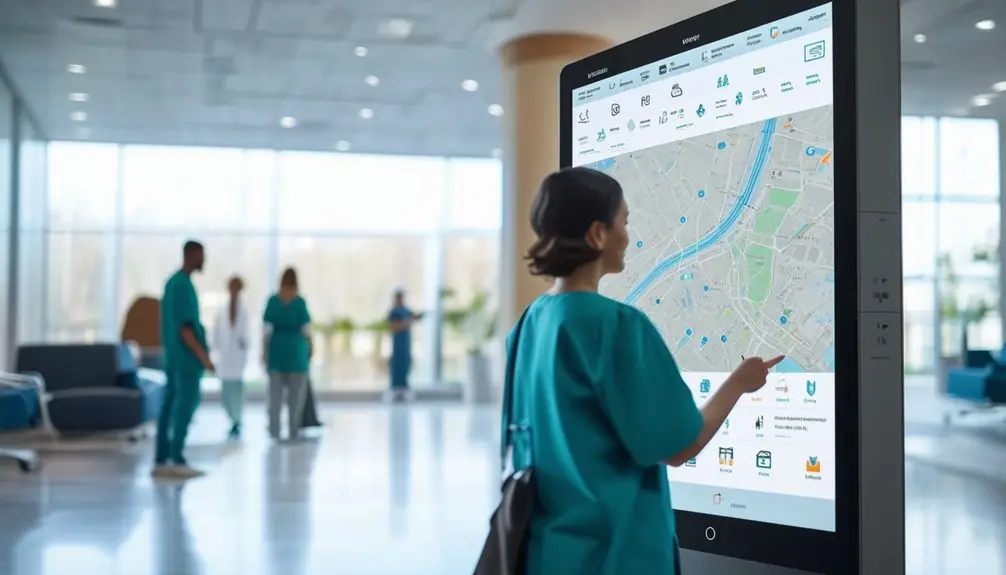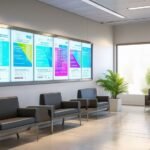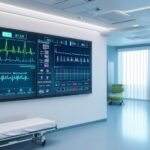Implementing touchscreen wayfinding systems in hospitals streamlines patient navigation and boosts operational efficiency. You’ll find features like customizable content, ADA compliance, and a range of screen sizes. These systems offer touch-free interaction, multi-lingual support, and even instant emergency messaging. Various technologies—interactive kiosks, mobile apps, voice assistants, and augmented reality—cater to different needs. Accessibility enhancements, such as audio instructions and closed captioning, secure a user-friendly experience for all. Numerous testimonials highlight the reliability and innovation of these systems, praising the excellent tech support. You’re about to uncover more on improving patient experience and operational success.
Key Takeaways
- Customizable touchscreen systems improve hospital navigation with real-time, multi-lingual support and touch-free interaction for hygiene.
- ADA compliance and accessibility features, including audio instructions and closed captioning, enhance user experience for all patients.
- Interactive kiosks, mobile apps with GPS, and voice-activated assistants offer personalized wayfinding solutions.
- Instant emergency messaging capabilities ensure rapid communication and safety in critical situations.
- Robust tech support and continuous customer service enhance the efficiency and reliability of wayfinding systems.
Key Features
The key features of touchscreen wayfinding systems for hospitals include customizable content and enclosures, a variety of screen sizes, solid-state players for reliability, ADA compliance for accessibility, and compatibility with Noventri approved data sources. When you’re implementing digital wayfinding, these customizable systems can be tailored to fit the unique layout and needs of your healthcare facility. The enclosures can be designed to blend seamlessly into high-traffic areas, guaranteeing that they’re both functional and aesthetically pleasing.
With a range of screen sizes available, you can place interactive kiosks in spots that maximize visibility and ease of use. These systems are pivotal for enhancing the patient experience and providing clear and intuitive indoor navigation. The solid-state players used in these systems ensure they remain operational around the clock, which is essential in a hospital setting where reliable wayfinding is essential.
ADA compliance is a must, ensuring that everyone, including individuals with disabilities, can easily access and use the wayfinding systems. Finally, compatibility with Noventri approved data sources means these systems can integrate smoothly with your existing digital infrastructure, providing real-time updates and accurate information. This guarantees a cohesive and efficient navigation solution for all users.
Benefits for Hospitals

Implementing touchscreen wayfinding systems in hospitals streamlines operations and greatly enhances the patient experience by providing real-time, accessible navigation and information. These systems leverage digital displays and voice-activated wayfinding to offer clear directions and immediate access to appointment details. By incorporating multi-lingual support, you guarantee that diverse populations can easily navigate the facility.
Touch-free wayfinding stations further enhance the patient experience by promoting a hygienic environment, reducing infection risks through voice interaction. You’ll find that these systems also improve accessibility for individuals with disabilities, providing a more inclusive healthcare environment. Additionally, they enable instant emergency messaging, ensuring quick and efficient communication during critical situations.
Here’s a quick overview of the benefits:
| Benefit | Description | Impact on Hospital Operations |
|---|---|---|
| Streamlined Operations | Efficient navigation and communication | Reduces staff workload and wait times |
| Enhanced Patient Experience | Real-time, accessible navigation and information | Increases patient satisfaction and comfort |
| Multi-Lingual Support | Directions and information in multiple languages | Serves diverse patient populations effectively |
| Touch-Free Interaction | Voice-activated, no-touch stations | Promotes hygiene, reduces infection risk |
| Instant Emergency Messaging | Immediate communication in critical situations | Ensures rapid response and safety |
Wayfinding Technologies
Hospitals are utilizing interactive kiosks, mobile apps with GPS, and voice-activated assistants to transform wayfinding for patients and visitors. These digital solutions streamline operations and enhance patient experience in healthcare facilities. Interactive touch-screen kiosks provide real-time information, effortlessly guiding patients through intricate hospital layouts. As a patient, you can access step-by-step directions and search functionalities directly from these kiosks.
Mobile apps with GPS offer a personalized wayfinding solution right on your smartphone, ensuring you never get lost while maneuvering the hospital. These apps are designed with user-friendly interfaces that make it simple to find your way, even if you’re unfamiliar with the facility. Voice-activated assistants add another layer of convenience, allowing you to get directions through straightforward voice commands.
Digital signage and augmented reality systems further enhance the wayfinding experience by providing visual cues and interactive maps. These technologies offer multi-lingual support, ensuring that language barriers don’t hinder orientation. Emergency messaging capabilities are also integrated into these systems, providing vital information promptly. By incorporating these advanced digital wayfinding solutions, healthcare facilities enhance the overall patient experience and operational efficiency.
Accessibility Enhancements
Touchscreen wayfinding systems prioritize accessibility by incorporating features like audio instructions and closed captioning, guaranteeing visually impaired individuals can navigate hospitals effortlessly. These systems enhance the wayfinding experience by providing spoken directions, which is particularly beneficial for those who rely on auditory cues. The inclusion of accessibility features makes it easier for everyone to use digital signage within healthcare settings.
Your hospital’s touchscreen wayfinding system should be ADA compliant, addressing the needs of individuals with various disabilities. This secures that everyone, regardless of their physical capabilities, can find their way around the facility without stress. The integration of multi-lingual support also caters to non-English speakers, offering directions in multiple languages to meet the needs of a diverse patient population.
Here’s a glimpse of how these features improve accessibility:
| Feature | Benefit | Impact |
|---|---|---|
| Audio Instructions | Supports visually impaired users | Enhanced navigation experience |
| Closed Captioning | Assists hearing-impaired individuals | Improved information accessibility |
| ADA Compliance | Meets legal accessibility standards | Inclusive design for all users |
| Multi-lingual Support | Provides languages options | Better service for non-English speakers |
Customer Testimonials

Drawing from a wealth of customer experiences, you’ll find that Zoney touchscreen wayfinding systems consistently receive high praise for their exceptional service and support. Carlos Lopez from Cooks Children’s Hospital highlights the reliability and innovation of their interactive kiosks and digital directories, making navigation across the hospital campus seamless for patients and visitors alike. Missy Elliott from UC Health commends the tech support for their healthcare solutions, emphasizing how the digital directories and wayfinding solutions notably improve the patient room-finding process.
These testimonials underline the importance of robust customer service in maintaining system efficiency and user satisfaction. Tanya Shubert from McWhirter Realty appreciates continued support services for their digital signage, reinforcing the company’s commitment to long-term partnerships and operational excellence. Customers consistently recommend Zoney for their reliable and innovative digital wayfinding solutions, which prove vital in enhancing the overall hospital experience.
When analyzing these insights, it’s clear that Zoney excels in providing user-centered wayfinding solutions. Interactive kiosks and digital directories are not just technological marvels but also essential tools in the navigational efficiency of any hospital campus.
Conclusion
Implementing touchscreen wayfinding systems in hospitals transforms patient experience and operational efficiency. You’ll appreciate the user-friendly interface, real-time updates, and enhanced accessibility features. This technology isn’t just a passing trend; it’s a long-term investment in patient satisfaction and streamlined workflows. Don’t just take our word for it—read the glowing testimonials. Embrace this cutting-edge solution and elevate your hospital’s navigation to the next level.
Frequently Asked Questions
What Is the Digital Signage Software for Hospitals?
Digital signage software for hospitals includes interactive kiosks, mobile apps, and displays. It provides real-time updates, turn-by-turn directions, and emergency messaging. You’ll benefit from enhanced accessibility, streamlined operations, and improved patient satisfaction through this technology.
What Methods Might Be Used to Improve Wayfinding in a Healthcare Facility?
Imagine a lighthouse guiding ships through fog: you can implement GPS-enabled mobile apps, interactive kiosks, digital signage, and augmented reality for clarity. Guarantee multi-lingual support and accessibility features to enhance everyone’s navigation experience in healthcare facilities.
What Is Hospital Wayfinding?
Hospital wayfinding uses digital tools to guide patients and visitors through healthcare facilities. You’ll get real-time directions, appointment info, and emergency alerts. Advanced features like voice assistants and multilingual support guarantee efficient, accessible navigation for everyone.
What Is Mobile Wayfinding?
Mobile wayfinding uses GPS to offer real-time, personalized guidance in hospitals. You can access it by scanning QR codes or visiting links. This tech enhances navigation, eliminates paper maps, and improves your overall patient experience.





